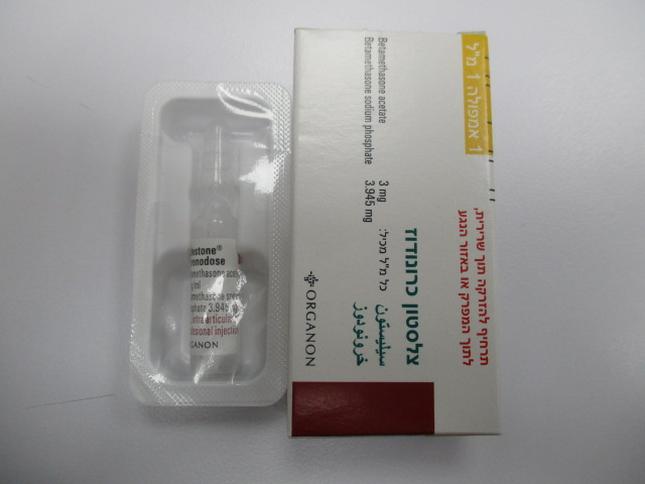Quest for the right Drug

צלסטון כרונודוז CELESTONE CHRONODOSE (BETAMETHASONE ACETATE, BETAMETHASONE SODIUM PHOSPHATE)
תרופה במרשם
תרופה בסל
נרקוטיקה
ציטוטוקסיקה
צורת מתן:
תוך-שרירי, תוך מפרקי, לתוך פצע : I.M, INTRA-ARTICULAR, INTRA-LESIONAL
צורת מינון:
תרחיף להזרקה : SUSPENSION FOR INJECTION
עלון לרופא
מינוניםPosology התוויות
Indications תופעות לוואי
Adverse reactions התוויות נגד
Contraindications אינטראקציות
Interactions מינון יתר
Overdose הריון/הנקה
Pregnancy & Lactation אוכלוסיות מיוחדות
Special populations תכונות פרמקולוגיות
Pharmacological properties מידע רוקחי
Pharmaceutical particulars אזהרת שימוש
Special Warning עלון לרופא
Physicians Leaflet
Pharmacological properties : תכונות פרמקולוגיות
Pharmacodynamic Properties
5.1 Pharmacodynamic properties Pharmacotherapeutic group: corticosteroid for systemic use, glucocorticoid, ATC code: H02A B01. Betamethasone is a synthetic glucocorticoid (9 alpha-fluoro-16 beta-methylprednisolone). Betamethasone has strong anti-inflammatory, immunosuppressive and anti-allergic activity. Betamethasone has no clinically significant mineralocorticoid effect. Glucocorticoids diffuse across cell membranes and form complexes with specific cytoplasmic receptors. These complexes then enter the cell nucleus, bind to DNA (chromatin) and stimulate the transcription of messenger RNA and protein synthesis of various enzymes. These are finally responsible for the effects observed in systemic glucocorticoid use. In addition to their significant effect on inflammatory and immune processes, glucocorticoids also influence the metabolism of carbohydrates, proteins and lipids. Finally, they also have an effect on the cardiovascular system, skeletal muscles and the central nervous system. Effect on inflammatory and immune processes The anti-inflammatory, immunosuppressive and anti-allergic properties of glucocorticoids account for a very substantial part of their therapeutic applications. The main aspects of these properties are: reduction in the number of immuno-active cells at the inflammatory site, reduced vasodilation, stabilization of lysosomal membranes, inhibition of phagocytosis, reduced production of prostaglandins and related substances. The anti-inflammatory activity is about 25 times greater than that of hydrocortisone, and 8 to 10 times greater than that of prednisolone (on a weight basis). 100 mg of hydrocortisone is equivalent to 4 mg of betamethasone. Effect on the metabolism of carbohydrates and proteins Glucocorticoids stimulate protein catabolism. In the liver, the released amino acids are converted into glucose and glycogen by the process of gluconeogenesis. Glucose uptake in peripheral tissues decreases, which leads to hyperglycemia and glucosuria, especially in patients with a diabetic predisposition. Effect on lipid metabolism Glucocorticoids have lipolytic activity. This lipolysis is more pronounced in the limbs. They also have a lipogenic effect that occurs mainly in the trunk, neck and head. As a whole, these effects lead to a redistribution of fat deposits. The maximum pharmacological activity of corticosteroids appears later than the peak serum levels, suggesting that the majority of effects of these medications are not based on direct activity of the medicinal product, but on the modification of enzyme activity.
Pharmacokinetic Properties
5.2 Pharmacokinetic properties Betamethasone disodium phosphate and betamethasone acetate are resorbed from the injection site and induce therapeutic effects and other pharmacological effects, both locally and systemically. Betamethasone disodium phosphate is highly soluble in water and is metabolized in the body into betamethasone, the biologically active steroid. 4 mg of betamethasone disodium phosphate is the equivalent of 3 mg of betamethasone. Betamethasone acetate, almost insoluble in water, is suspended in the preparation Celestone Chronodose. This corticosteroid ester is slowly hydrolyzed at the injection site. After oral and parenteral administration, the plasma half-life of betamethasone is >5 hours. The biological half-life is between 36 and 54 hours. After IM injection, the peak plasma concentration of betamethasone disodium phosphate is recorded after 60 minutes, and the corticosteroid is excreted almost completely on the first day. Pharmacological activity persists after the disappearance of measurable plasma levels. Betamethasone is metabolized in the liver. Betamethasone binds primarily to albumin. In patients with a liver disorder, its clearance is slower or delayed.

שימוש לפי פנקס קופ''ח כללית 1994
Rheumatoid arthritis, osteoarthritis, other arthritic conditions by intra-articular injection, inflammatory, allergic & rheumatic conditions requiring a glucocorticoid effect, in patients for whom treatment with oral corticosteroid is not feasible. יירשם ע"י רופא אורטופד
תאריך הכללה מקורי בסל
01/01/1995
הגבלות
תרופה מוגבלת לרישום ע'י רופא מומחה או הגבלה אחרת
מידע נוסף
